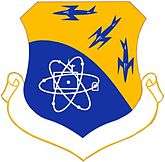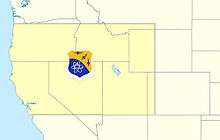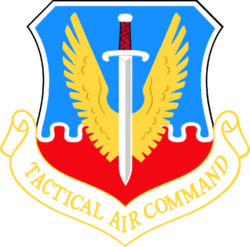26th Air Division
| 26th Air Division | |
|---|---|
|
| |
| Active | 1948–1952; 1952–1969; 1969–1990 |
| Country |
|
| Branch |
|
| Role | Command of air defense forces |
| Part of | Tactical Air Command |
| Decorations | Air Force Outstanding Unit Award |
| Insignia | |
| 26th Air Division emblem (Approved 17 November 1960)[1] |
 |
The 26th Air Division (26th AD) is an inactive United States Air Force organization. Its last assignment was with Air Defense Tactical Air Command, assigned to First Air Force, being stationed at March Air Force Base, California. It was inactivated on 30 September 1990.
History

Was established in October 1948 by Air Defense Command (ADC) as intermediate level of command.[1] Initially responsible for atmospheric air defense of middle Atlantic region from North Carolina to greater New York City area east of the Appalachian mountains. Commanded Manual Direction Center (MDC) at Roslyn Air Force Station, New York (P-3) 1948-1958 directing interceptor units to aircraft identified by Aircraft Control and Warning Squadrons at radar stations in AOR. It employed off shore naval picket ships, fixed "Texas Tower" radar sites, airborne early warning units, and a civilian Ground Observer Corps program. The latter phased down when the SAGE program was implemented.
Improved radar and communications equipment and fighter interceptors, and better techniques and methods, eventually led to the 26th Air Division becoming the first operational Semi Automatic Ground Environment SAGE Direction Center (DC-1) within Air Defense Command[1] at McGuire Air Force Base, New Jersey.[2] Moved to Syracuse Air Force Station New York[1] and commanded SAGE DC-3 Direction Center and first SAGE Command Center (CC-01) beginning in 1958 and assumed operational control of the MDC at Topsham Air Force Station, Maine in August 1958 and the SAGE DC-4 at Fort Lee Air Force Station, Virginia in September 1958.
In 1961 the division assumed air defense training responsibility for Air National Guard (ANG) units within the area. During the Cuban Missile Crisis of 1962, the division deployed fighter aircraft and part of its airborne early warning and control force to Florida.[1]
The 26th's area of control expanded until by 1963 its boundaries extended from the Arctic to the Gulf of Mexico and well toward the center of the United States. Expanded responsibilities in 1963 assuming command of SAGE DC-9 at Gunter Air Force Base, Alabama in July and DC-6 at Custer Air Force Station, Michigan in September and GCI stations in Newfoundland and Labrador formerly under the 64th Air Division.

In April 1966, the division was replaced by the First Air Force, and moved without personnel or equipment to Adair Air Force Station, Oregon, where it assumed responsibility for the defense of Oregon, part of California and Nevada[1] by the inactivation of the Portland and Reno Air Defense Sectors. Assumed additional designation of 26th NORAD Region and 26th CONAD Region after activation of the NORAD Combat Operations Center at the Cheyenne Mountain Complex, Colorado and reporting was transferred to NORAD from ADC at Ent Air Force Base in April 1966.

The division was gradually phasing down until it replaced the 27th Air Division at Luke Air Force Base, Arizona in November 1969,[1] when in an ADCOM reorganization of atmospheric defense forces, the command became responsible for the air defense of a large area of the southwest. In October 1979, it transferred to Tactical Air Command (ADTAC) and continued to supervise atmospheric defense forces of its assigned AOR. Assumed additional designation 26th ADCOM Region on 8 December 1978.
Began phase-down of operations with activation of new Southwest Air Defense Sector (SWADS) in July 1987. Engaged chiefly in transfer of mission to SWADS 1987-1990. Inactivated on 1 October 1990.[1]
Lineage
- Established as the 26th Air Defense Division on 21 October 1948
- Activated on 16 November 1948
- Re-designated: 26th Air Division (Defense) on 20 June 1949
- Inactivated on 1 February 1952
- Organized on 1 February 1952[3]
- Redesignated 26th Air Division (SAGE) on 8 August 1958
- Redesignated 26th Air Division on 1 April 1966
- Inactivated on 30 September 1969
- Reactivated on 18 November 1969
- Organized on 19 November 1969
- Inactivated on 30 September 1990[1]
Assignments
|
|
Stations
- Mitchel Air Force Base, New York, 16 November 1948
- Mitchel Air Force Base Sub Base #3, (later) Roslyn Air Force Station, New York, 18 April 1949
- Syracuse Air Force Station (later Hancock Field), New York, 15 August 1958
- Stewart Air Force Base, New York, 15 June 1964
- Adair Air Force Base, Oregon, 1 April 1966 – 30 September 1969
- Luke Air Force Base, Arizona 19 November 1969
- March Air Force Base, California, 31 August 1983 – 1 July 1987[1]
Components
Air Force
- Keflavik Airport, Iceland, 1 July-4 September 1963[1]
Sectors
|
|
Wings
|
|
Groups
|
|
Interceptor squadrons
- Travis Air Force Base, California, 1 April-25 June 1966
- Hamilton Air Force Base, California, 1 October 1970 – 1 September 1973
- Castle Air Force Base, California, 1 September 1973 – 1 July 1987
- Castle Air Force Base, California, 1 April 1966 – 18 July 1968[1]
Radar squadrons
|
|
Radar evaluation squadron
- 4758th Radar Evaluation Squadron (ECM)
- Griffiss Air Force Base, New York, 1 July-20 October 1959[1]
See also
- List of United States Air Force air divisions
- List of USAF Aerospace Defense Command General Surveillance Radar Stations
- Aerospace Defense Command Fighter Squadrons
References
Notes
- 1 2 3 4 5 6 7 8 9 10 11 12 13 14 15 16 17 "Factsheet 26 Air Division". Air Force Historical Research Agency. October 5, 2007. Archived from the original on 10 November 2012. Retrieved April 9, 2014.
- ↑ Preface by Buss, L. H. (Director) (14 April 1959). North American Air Defense Command and Continental Air Defense Command Historical Summary: July–December 1958 (Report). Directorate of Command History: Office of Information Services. "USAF also set down a new schedule (see table preceding). This schedule was to be included in an entirely new SAGE schedule (Schedule A) to be prepared by the SAGE Project Office. The phasing was to be as follows. The last combat center, AN/FSQ-8, to be installed under SAGE Schedule 7 (Improved), was to be at McChord AFB (25th Air Division). Subsequent combat facilities and equipment were to be cancelled with the exception of (1) one AN/FSQ-8 that was to be converted to an AN/FSQ-7, using FY 1959 funds, to be installed at the Sioux City DC, and (2) the combat center building at Minot." (improved) On April 1, 1966, Combat Center CC-03 at McChord AFB, WA was inactivated in conjunction with the activation of Combat Center CC-05 at Hamilton AFB, CA, and the combining of 25th, 26th and 27th NORAD divisions into the new Headquarters Western NORAD Region at HAFB. CC-05 utilized a 3-String AN/GSA-51 computer system. CC-05 and Headquarters Western NORAD Region were inactivated at Hamilton AFB on December 31, 1969.
- ↑ The simultaneous activation and reactivation on 1 February 1952 reflects a change from a Table of Organization unit to a Table of Distribut8on unit.
Bibliography
![]() This article incorporates public domain material from the Air Force Historical Research Agency website http://www.afhra.af.mil/.
This article incorporates public domain material from the Air Force Historical Research Agency website http://www.afhra.af.mil/.
- Cornett, Lloyd H; Johnson, Mildred W (1980). A Handbook of Aerospace Defense Organization, 1946–1980 (PDF). Peterson AFB, CO: Office of History, Aerospace Defense Center.
- Maurer, Maurer, ed. (1983) [1961]. Air Force Combat Units of World War II (PDF) (reprint ed.). Washington, DC: Office of Air Force History. ISBN 978-0-912799-02-5.
- Maurer, Maurer, ed. (1982) [1969]. Combat Squadrons of the Air Force, World War II (PDF) (reprint ed.). Washington, DC: Office of Air Force History. ISBN 0-405-12194-6. LCCN 70605402. OCLC 72556.
- Ravenstein, Charles A. (1984). Air Force Combat Wings, Lineage & Honors Histories 1947-1977 (PDF). Washington, DC: Office of Air Force History. ISBN 0-912799-12-9.


